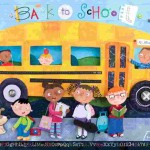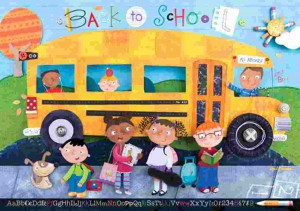I recently received this nice article in my inbox from Connie Hammer from the Autism Newsletter from www.AutismTeachingTools.net & www.AutismResourceCenterofSouthFlorida.com
It is quite a nice resource and worth reading–>
Eleven Back to School Strategies to Reduce School Anxiety for Children with Autism
By Connie Hammer
Transitions are very difficult for most children on the autism spectrum to make and going back to school may be the most challenging one there is. Preparing a child for change can be time consuming and emotionally draining for any family. We all hope for a stress free and easy shift into a new school routine but don’t always get what we want. If despite all your preparation the new school year did not get off to a good start, don’t despair because it is never too late to turn things around. All parents want things to go smoothly and when they don’t it is all too easy to place blame on yourself. But wait!Eleven Back to School Strategies to Reduce School Anxiety for Children with Autism
By Connie Hammer
Before jumping to conclusions that you did something wrong or that your child will never settle into a peaceful back to school routine let’s approach this from a different perspective. When an airplane pilot develops problems flying an aircraft or a sea captain experiences difficulty with his ship the trouble could stem from a number of things. Most likely both of these skilled professionals will run through a checklist to assess the situation and determine the cause. The first step towards solving any dilemma is assessment and a checklist is a great way to examine most potentially problematic situations.Having a checklist also helps one tackle a challenge with more confidence and less stress.
Depending on the qualities that make your child unique and where he or she falls on the autism spectrum, your back to school experience will differ from every other parent. If you are experiencing turbulence or rough seas in your household as you try to settle into a stress free back to school routine here is a checklist for you to refer to that may help you identify some adjustments that will make for a smoother transition.
___ Are you paying attention to your child’s sleep patterns and bedtime routine?
If you weren’t able to address changes in daily routines, such as bedtime, well enough in advance this could be the cause of any stress related behaviors that might be occurring. One cannot stress the importance of sleep and its impact on brain development, mood and attention span which many studies support. In addition to helping your child be more successful at school, making sure she receives the required amount of sleep will also improve her behavior at home.___ Are you using a back to school calendar?
If not, consider creating a special back-to-school calendar. Depending on your child’s interest in arts and crafts, this can be a fun process that the two of you can do together. You may want to use words or pictures to indicate what will happen on each day of the week, if you need more room and can’t find a calendar big enough, such as a wall calendar, make a book that has a page or two or for every day of the week. Reading the book or looking at the calendar can you’re your child transition better from day to day.___ Have you used other school related resources to your advantage?
If you have any books or movies about school this would be a good time to read or watch them repeatedly. If your supply of school related resources is scarce consider a trip to the bookstore to purchase a new book or the more economical option of the public library which allows you to take home more than one book or video. One can always find books about going back to school.___ Have you been talking about school in a positive manner?
When talking about school with your child on the autism spectrum, it is always important to set up a positive attitude for the upcoming school year before and after it begins. Talking to them in the affirmative regarding teachers, friends and schoolwork will help them maintain a positive perspective and relieve any anxieties that might exist. If despite your positive attitude, your child is not enthused about the school year, focus on activities and events they find interesting, such as sports, arts, clubs, field trips, etc. If you really need to dig deep try to find something positive to say about what will happen after school.___ Did you and your child have a private meeting with the teacher?
If your child is exceptionally anxious about the start of a new school year and the changes that are involved, making a fifteen to twenty minute appointment to talk to the new teacher before or after school might help. The opportunity to have a private audience with the teacher to go over schedules and expectations as well as the chance to ask questions without other students around can give any child a gigantic jump start and sense of relief.___ Have you reviewed previous school years by looking at pictures?
If you don’t have any pictures, start taking them now or if your school has a yearbook, make sure to purchase one when it is published. If using your own pictures consider putting them in a scrapbook this year, which may be fun to create together. Next year you can take the yearbook or scrapbook out at this time and look through it together, it can be a useful transition tool for returning to school the following year.___ Have you held a family meeting about school?
In addition to talking about school to your child individually, it’s great to hold a family meeting so that everyone gets a chance to share their thoughts and feelings as well as discuss and plan for the week ahead. Meeting as a group sends the message that you are all in this together and that you care about each individual’s experience. If you have never held a family meeting before, this is good time to start.___ Have you and your child met with the school bus driver?
If taking the bus, it can be very beneficial for you to meet with the bus driver and provide him or her with helpful information about your child. A school bus is a very sensory stimulating environment – bus fumes, noise, temperatures, stops and starts, etc. – not to mention an atmosphere that could be socially intimidating to your children with autism. You may even want to consider creating a driver tip sheet, especially if you suspect the bus ride is causing high-anxiety or sensory overload for your child. A tip sheet might include important information about your child and how best to communicate with him, simple strategies that work, tactics to avoid, seating preference or activities that will maintain his interest.___ Have you addressed screen machine use?
If you have allowed TV viewing, video games and computer use privileges to increase over the summer and haven’t had a chance to cut back yet, begin now. Technology is important and useful but must be balanced with other activities that create an atmosphere where the brain is encouraged and allowed to think for itself. Quiet time for reading, homework and social interaction is vitally important for helping your child be successful in school. Once you adjust TV, video and computer use rules it is important to communicate them clearly and stick to them.___ Are you encouraging social interactions for your child?
A child on the autism spectrum often struggles with making and keeping friends, which is an important component in creating a positive school experience. If possible, invite old or new classmates that may have moved into the school system and invite them over so your child can get to know them better and practice her social graces. It can help your child immensely if you rehearse back to school conversation starters and group social skills with them to use with their friends, teachers and other adults.___ Are you communicating clearly with your child?
It is important to remember that all the preparation, planning and practice in the world won’t get you to where you want to be if you aren’t communicating effectively with your child – verbally and non-verbally. It is important to know what works best to effectively communicate with your child. Does your autistic child communicate best with words, or visuals and how can you tell when your message has been received and you have made a good connection?Before you think about making changes to your back to school schedule, take the time to review this checklist and note what comes to mind. Be open and honest in assessing your current routine and then choose a few things to work on as you tweak your original approach. In order to create a more productive and enjoyable back to school routine for you and your child, make changes gradually and keep track of what works and what doesn’t. Before you know it, you and your child will be experiencing a stress free school routine.
Imagine less worries and less concerns as a parent with a child on the Autism spectrum… and more happiness and joyful times as a family. That’s what you get when have the support of Connie Hammer, expert parent educator and coach. For more than twenty years, this licensed social worker has worked with families to uncover abilities and nurture family opportunities that bring more love, more fun and more contentment, regardless of disability, into their lives.
About Connie Hammer. For more than twenty years, this licensed social worker has worked with parents to uncover abilities and change family possibilities that bring more love, fun and contentment, regardless of disability, into their lives. To find out more about this internationally published expert and get your FREE resources – a parenting ecourse, Parenting a Child with Autism – 3 Secrets to Thrive and a weekly parenting tip newsletter, The Spectrum, – visit her website www.parentcoachingforautism.com.


